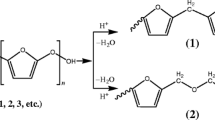Abstract
Synthetic hectorite clay minerals were hydrothermally crystallized with direct incorporation of a series of five water-soluble polyvinyl alcohols (PVA) of molecular weights from 9000-146,000. The molecular weight of PVA had little effect on the success of hydrothermal hectorite synthesis, d-spacing or the amount of polymer incorporated. The basal spacings range from 19.5 Å to 20.8 Å and the amount of polymer incorporated ranges from 20 wt.% to 23 wt.%. Incorporation of PVA within the clay inter-layers, along with Li(I) ions to compensate the lattice charge, is indicated. Thermal gravimetric analysis and small angle neutron scattering were used to further examine the polymer-clay systems. Small PVA-clay crystallites that are coated with excess PVA are indicated. Removal of the polymer does not alter the extended synthetic clay network, and the nitrogen BET surface area increases from <5 m2/g to >200 m2/g.
Similar content being viewed by others
Explore related subjects
Discover the latest articles, news and stories from top researchers in related subjects.References
Aranda P, Ruiz-Hitzky E. 1992. Poly(ethylene oxide)-silicate intercalation compounds. Chem Mater 4:1395–1403.
Bandosz TJ, Jagiello J, Andersen B, Schwarz JA. 1992a. Inverse gas chromatography study of modified smectite surface. Clays & Clay Miner 40:306–310.
Bandosz TJ, Jagiello J, Amankwah KAG, Schwarz JA. 1992b. Chemical and structural properties of clay minerals modified by inorganic and organic material. Clay Miner 27: 435–444.
Bandosz TJ, Putyera K, Jagiello J, Schwarz JA. 1993. Applications of inverse gas chromatography to the study of the surface properties of modified layered materials. Mi-cropor Mater 1:73–79.
Barrer RM. 1978. Zeolites and clay minerals as sorbents and molecular sieves. New York: Academic Press, p 430.
Carrado KA, Thiyagarajan P, Winans RE, Botto RE. 1991. Hydrothermal crystallization of porphyrin-containing layer silicates. Inorg Chem 30:794–799.
Carrado KA. 1992. Preparation of hectorite clays utilizing organic and organometallic complexes during hydrothermal crystallization. Ind Eng Chem Res 31:1654–1659.
Carrado KA, Forman JE, Botto RE, Winans RE. 1993. Incorporation of phthalocyanines by cationic and anionic clays via ion exchange and direct synthesis. Chem Mater 5:472–478.
Carrado KA, Winans RE, Botto RE. 1994. Organic or organometallic template mediated clay synthesis. U.S. Patent 5,308,808.
Carrado KA, Thiyagarajan P, Elder DL. 1995. Synthetic polymer-layer silicate clay composites. Prepr Pap—Am Chem Soc, Div of Petrol Chem 40:310–313.
Carrado KA, Thiyagarajan P, Elder DE. 1997. “Synthesis of microporous materials: Zeolites, clays, and nanostruc-tures.” In: Occelli ML, Kessler H, editors. Porous networks derived from synthetic polymer-clay complexes. New York: Marcel-Dekker. p 551–565.
Chang S-H, Ryan ME, Gupta RK, Swiatkiewicz B. 1991. The adsorption of water-soluble polymers on mica, talc, limestone, and various clay minerals. Coll Surf 59:59–70.
Ege D, Ghosh PK, White JR, Equey J-F, Bard AJ. 1985. Clay modified electrodes. 3. Electrochemical and electron spin resonance studies of montmorillonite layers. J Am Chem Soc 107:5644–5652.
Greenland DJ. 1963. Adsorption of polyvinyl alcohols by montmorillonite. J Coll Sci 18:647–664.
Grim RE. 1968. Clay mineralogy. New York: McGraw-Hill. p86.
Kato C, Kuroda K, Misawa M. 1979. Preparation of mont-morillonite-nylon complexes and their thermal properties. Clays & Clay Miner 27:129–136.
Kato C., Kuroda K, Takahara H. 1981. Preparation and electrical properties of quaternary ammonium montmorillonite-polystyrene complexes. Clays & Clay Miner 29:294–298.
Lagaly G. 1986. Developments in ionic polymers. In: Wilson AD, Prosser HT, editors. London: Applied Science Publ. p 77–140.
Lan T, Kaviratna PD, Pinnavaia TJ. 1994. On the nature of polyimide-clay hybrid composites. Chem Mater 6:573–575.
Messersmith PB, Giannelis EP. 1993. Polymer-layered silicate nanocomposites: in situ intercalative polymerization of €-caprolactone in layered silicates. Chem Mater 5:1064–1066.
Newman ACD. 1987. Chemistry of clays and clay minerals. Essex, England: Longman Scientific & Technical (Mineralogical Society No. 6). p 257–259.
Ogawa M, Inagaki M, Kodama N, Kuroda K, Kato C. 1993. Novel controlled luminescence of tris(2,2’-bipyridi-ne)ruthenium(II) intercalated in a fluortetrasilicic mica with poly(vinylpyrrolidone). J Phys Chem 97:3819–3823.
Ogawa M, Takahashi M, Kuroda K. 1994. Intercalation of p-nitroaniline into tetramethyl-ammonium saponite film under electric field and its optical second harmonic generation. Chem Mater 6:715–717.
Okada A, Kawasumi M, Usuki A, Kojima Y, Kurauchi T, Kamigaito O. 1990. Nylon 6-clay hybrid. Mater Res Soc Symp Proc 171:45–50.
Putyera K, Bandosz TJ, Jagiello J, Schwarz JA. 1994. Sorption properties of carbon composite materials formed from layered clay minerals. Clays & Clay Miner 42:1–6.
Ruiz-Hitzky E, Aranda P. 1990. Polymer-salt intercalation complexes in layer silicates. Adv Mater 2:545–547.
Schamp N, Huylebroeck J. 1973. Adsorption of polymers on clays. J Polymer Sci 42:553–562.
Schwieger W, Werner P, Bergk KH. 1991. A new synthetic layered silicate of type metal silicate hydrate. Coll Polym Sci 269:1071–1073.
Suzuki K, Masakazu H, Masuda H, Mori T. 1992. Adsorptive properties of swelling clays for poly(vinyl alcohol). Nendo Kagaku 32:36–41.
Theng BKG. 1979. Formation and properties of clay-polymer complexes. Amsterdam: Elsevier. 362 p.
Theng BKG. 1982. Clay-polymer interactions: summary and perspectives. Clays & Clay Miner 30:1–10.
Wu J, Lerner MM. 1993. Structural, thermal, and electrical characterization of layered nanocomposites derived form Na-montmorillonite and polyethers. Chem Mater 5:835–838.
Author information
Authors and Affiliations
Additional information
The submitted manuscript has been authored by a contractor of the U.S. Government under contract No, W-31-109- ENG-38. Accordingly, the U.S. Government retains a nonexclusive, royalty-free license to publish or reproduce the published form of this contribution, or allow others to do so, for U.S. Government purposes.
Rights and permissions
About this article
Cite this article
Carrado, K.A., Thiyagarajan, P. & Elder, D.L. Polyvinyl Alcohol-Clay Complexes Formed by Direct Synthesis. Clays Clay Miner. 44, 506–514 (1996). https://doi.org/10.1346/CCMN.1996.0440409
Received:
Accepted:
Published:
Issue Date:
DOI: https://doi.org/10.1346/CCMN.1996.0440409




